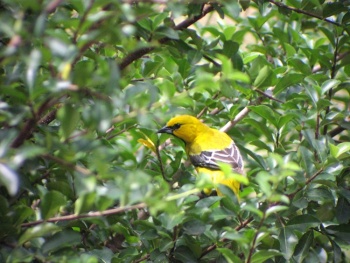(Referenced for copied text) |
(Attempt to disguise copied text. Taxonomy expanded. References updated.) |
||
| Line 1: | Line 1: | ||
| − | |||
| − | |||
'''Disambiguation: The name Yellow Oriole or Australian Yellow Oriole is sometimes used for [[Green Oriole]]''' | '''Disambiguation: The name Yellow Oriole or Australian Yellow Oriole is sometimes used for [[Green Oriole]]''' | ||
| + | [[Image:Yellow_Oriole.jpg|thumb|550px|right|Photo by {{user|Steve+G|Steve G}}<br /> [[Asa Wright Nature Centre]], [[Trinidad]], May 2006]] | ||
| + | ;[[:Category:Icterus|Icterus]] nigrogularis | ||
==Identification== | ==Identification== | ||
| − | + | 20–21 cm<br /> | |
| − | + | '''Male''' | |
| + | *Yellow plumage | ||
| + | *Black wings | ||
| + | *Black eye mask | ||
| + | *narrow black throat line | ||
| + | *Black tail | ||
| + | *White wing bar | ||
| + | The female is similar but duller<br /> | ||
| + | Juvenile has an olive-tinged yellow back, and no black on the face. | ||
| + | [[Image:7881Yellow Oriole3s.jpg|thumb|350px|right|Immature<br />Photo by {{user|Jacamar|Jacamar}}<br />Glasgow, East Bank Berbice, [[Guyana]], March 2005]] | ||
==Distribution== | ==Distribution== | ||
Northern [[South America]] in [[Colombia]], [[Venezuela]], [[Trinidad]], the [[Guianas]] and northern [[Brazil]]. | Northern [[South America]] in [[Colombia]], [[Venezuela]], [[Trinidad]], the [[Guianas]] and northern [[Brazil]]. | ||
==Taxonomy== | ==Taxonomy== | ||
| − | There are four subspecies | + | ====Subspecies==== |
| − | *''I. n. nigrogularis'' | + | There are four subspecies<sup>[[#References|[1]]]</sup> of which three are restricted to islands. They differ from the widespread nominate race of the mainland in body and bill size, and minor plumage details. |
| − | *''I. n. curasoensis'' | + | *''I. n. nigrogularis'': |
| − | *''I. n. helioeides'' | + | :*Coastal northern [[Colombia]] to [[Venezuela]], the [[Guianas]] and northern [[Brazil]] |
| − | *''I. n. trinitatis'' | + | *''I. n. curasoensis''; |
| − | + | :*[[Netherlands Antilles]] (Aruba, Curaçao and Bonaire) | |
| + | *''I. n. helioeides'': | ||
| + | :*Isla Margarita (off northern Venezuela) | ||
| + | *''I. n. trinitatis'': | ||
| + | :*Nort-eastern Venezuela (eastern Paria Peninsula); [[Trinidad]] and Monos Island | ||
==Habitat== | ==Habitat== | ||
| − | + | Dry and semi-arid open woodland, scrub and gardens. | |
==Behaviour== | ==Behaviour== | ||
| − | + | ====Breeding==== | |
| − | Diet | + | The nest is a 40 cm long hanging basket, which is suspended from the end of a branch. The normal clutch is three pale green or grey eggs. |
| − | + | ====Diet==== | |
| + | The diet consists mainly of large insects, but will also eat nectar and some fruit. | ||
| + | ====Vocalisation==== | ||
| + | '''Song''': a tuneful fluting, with some buzzing.<br /> | ||
| + | '''Calls''': a cat-like whine, and chattering noises. | ||
==References== | ==References== | ||
| − | #{{Ref- | + | #{{Ref-Clements6thAug14}}#Handbook of the Birds of the World Alive (retrieved November 2014) |
| + | #Wikipedia | ||
{{ref}} | {{ref}} | ||
==External Links== | ==External Links== | ||
{{GSearch|Icterus+nigrogularis}} | {{GSearch|Icterus+nigrogularis}} | ||
[[Category:Birds]][[Category:Icterus]] | [[Category:Birds]][[Category:Icterus]] | ||
Revision as of 22:19, 11 November 2014
Disambiguation: The name Yellow Oriole or Australian Yellow Oriole is sometimes used for Green Oriole
- Icterus nigrogularis
Identification
20–21 cm
Male
- Yellow plumage
- Black wings
- Black eye mask
- narrow black throat line
- Black tail
- White wing bar
The female is similar but duller
Juvenile has an olive-tinged yellow back, and no black on the face.
Distribution
Northern South America in Colombia, Venezuela, Trinidad, the Guianas and northern Brazil.
Taxonomy
Subspecies
There are four subspecies[1] of which three are restricted to islands. They differ from the widespread nominate race of the mainland in body and bill size, and minor plumage details.
- I. n. nigrogularis:
- I. n. curasoensis;
- Netherlands Antilles (Aruba, Curaçao and Bonaire)
- I. n. helioeides:
- Isla Margarita (off northern Venezuela)
- I. n. trinitatis:
- Nort-eastern Venezuela (eastern Paria Peninsula); Trinidad and Monos Island
Habitat
Dry and semi-arid open woodland, scrub and gardens.
Behaviour
Breeding
The nest is a 40 cm long hanging basket, which is suspended from the end of a branch. The normal clutch is three pale green or grey eggs.
Diet
The diet consists mainly of large insects, but will also eat nectar and some fruit.
Vocalisation
Song: a tuneful fluting, with some buzzing.
Calls: a cat-like whine, and chattering noises.
References
- Clements, J. F., T. S. Schulenberg, M. J. Iliff, D. Roberson, T. A. Fredericks, B. L. Sullivan, and C. L. Wood. 2014. The eBird/Clements checklist of birds of the world: Version 6.9., with updates to August 2014. Downloaded from http://www.birds.cornell.edu/clementschecklist/download/
- Handbook of the Birds of the World Alive (retrieved November 2014)
- Wikipedia
Recommended Citation
- BirdForum Opus contributors. (2024) Yellow Oriole. In: BirdForum, the forum for wild birds and birding. Retrieved 13 May 2024 from https://www.birdforum.net/opus/Yellow_Oriole





